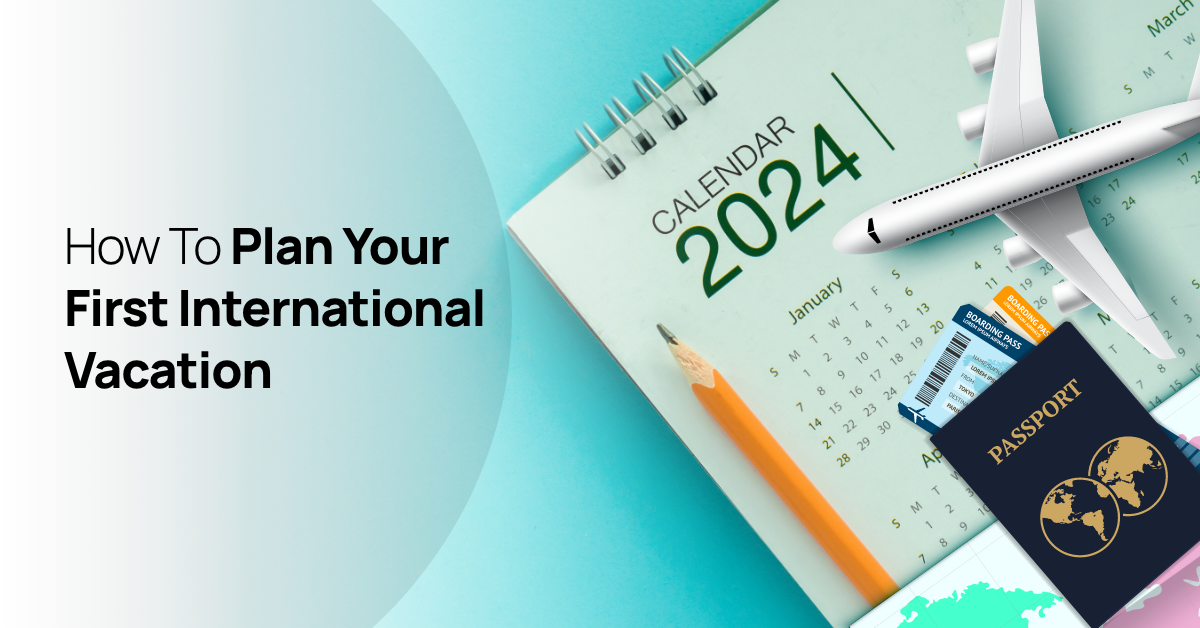A Complete Travel Guide for Your First International Vacation
By OneCard | April 22, 2024

Embarking on your first international trip can be exciting and overwhelming. It’s a perfect way to celebrate your hard work, explore new cultures, and make endless memories. But with so many details to consider, planning your first international trip can leave you in a fix. Don’t fret, it is easier than it seems, and with this extensive guide, you can tackle everything from deciding on a destination to arranging visas and figuring out your budget.
Key Factors to Consider While Choosing the Destination
Going on an international trip without planning is a rookie mistake. You can start by identifying your travel interests and purpose, like history, adventure, or culture. Here are a few key pointers to note while you arrive at this decision:
1. Location, Scheduling, and Weather
The first step in planning your international trip is to decide on tourist destinations that thrill you. Do the pristine beaches in the Maldives call out to you? Or do you wish to get lost in the Scottish Highlands? Ask yourself what excites you the most before landing on a location. Besides, climate conditions are significant for travel, too. For instance, visiting Switzerland to witness snow-capped mountains may not be ideal for someone with a low cold tolerance. It is always advisable to look out for extreme weather conditions, typical weather patterns, and day-to-day temperatures.
2. Connectivity
Consider factors like flight travel time and inter-city commute. For first-time international travel, you’d want to pick a destination that is easily accessible within the city and even from the airport, resulting in saving time and money. If you plan to visit metro cities like New York or London, taking the underground metro or subways for your intercity commute is a feasible alternative to taxis.
3. Currency
Staying informed about the currency exchange rate is important for budgeting. Your overall budget will depend heavily on conversion rates against the Rupee. Places like Nepal and Indonesia will increase your purchasing power, whereas a trip to the UK might put a bigger hole in your pocket due to the Pound Sterling’s higher exchange rates. In times like these, using a credit card with a low or zero Forex fee might come in handy and offer convenience instead of carrying foreign currency cash.
4. Safety and Security
When travelling overseas, it is pivotal to look out for local rules, regulations, and safety measures beforehand. Stay updated with local authorities’ contact details, keep local cab numbers handy, and ensure you follow the local laws and civil rules while exploring the city, especially at night. Be vigilant about financial frauds as well – avoid using ATM cards in poorly lit areas that might be prone to skimming devices. Using a credit card is a safer bet in these situations.
5. Local Culture and Customs
Before leaving for your international trip, research local cultures, cuisines and customs. Read the rules of your destination country to avoid offending their culture. Immerse yourself among the locals and indulge in their delicacies to make the most of your trip.
Also read: Trending international destinations with easy visa for Indian travellers.
Planning Your Budget
International trips can be expensive if not planned in advance. Prioritise experience over extravagance, and add a resourceful approach to your trip planning by considering these factors:
1. Prepare Your Itinerary
Research and outline your trip with a list of activities and adventures you want to explore according to your liking and preferences. This will include flight details, hotel information, and basic daily activities. This helps you analyse your budget and plan for the trip better. For instance, the Louvre Museum in Paris is closed on Tuesdays, so you will want to plan other activities or sightseeing to utilise the day.
2. Deciding Your Budget
The most important aspect of trip planning is estimating your overall budget. Researching costs in your destination country will help you make a realistic budget. Factor in all costs in your budget, such as accommodation, flight, travel, food, and other miscellaneous expenses.
3. Categorise Your Expenses
It makes sense to break down your expenses into several categories: transportation, activities, meals, etc. This will help you allocate your budget across the trip and stay within your means. OneCard app dashboard has an inbuilt feature called OneTrips, which provides a detailed expense tracker to help you stay on your budget.
4. Book Flights and Accommodation in Advance
Now that your itinerary and budget are in place, it’s time to make the bookings. Look for the best deals on SkyScanner, Kayak, MakeMyTrip, and more. One Credit Card provides exciting offers on multiple travel platforms, further easing down your trip planning.
5. Research For Free or Low-Cost Attractions
Many destinations offer free or low-cost sightseeing attractions like museums, parks, exhibitions, etc. Create a list of these budget-friendly activities or attractions. Additionally, there are also group offers that can make your trip more affordable.
Travelling internationally can seem like an intimidating prospect, but with sufficient planning and preparation, your trip can be a rewarding and unforgettable experience. Transform your dream into reality without putting a dent in your pocket. So mark your calendars, pack your bags, and get set for your dream international trip!
**Disclaimer: The information provided in this webpage does not, and is not intended to, constitute any kind of advice; instead, all the information available here is for general informational purposes only. FPL Technologies Private Limited and the author shall not be responsible for any direct/indirect/damages/loss incurred by the reader for making any decision based on the contents and information. Please consult your advisor before making any decision.



Credit Card Transaction Failed: Money Debited? Here's What To Do
Sharing is caring 😉